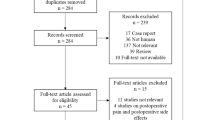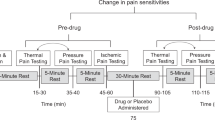Abstract
Purpose
To investigate interindividual variability in response to pain treatment, we characterized postoperative patients for morphine metabolism and for COMT, OPRM1 and UGT2B7 polymorphisms.
Methods
A total of 109 patients treated with morphine were genotyped by DNA sequencing for 12 DNA polymorphisms of the COMT, OPRM1 and UGT2B7 genes. The plasma concentration of morphine and of M3G/M6G metabolites were evaluated by means of reversed phase high-performance liquid chromatography coupled with mass spectrometry.
Results
An association between average morphine consumption during the first 24 postoperative hours by patient-controlled analgesia (PCA) and COMT haplotypes was found. Specifically, patients with the diplotype for average pain intensity (APS/APS) required the lowest morphine doses compared to the other subjects (p = 0.011). The APS haplotype contains an adenine corresponding to methionine, instead of valine, at position 158 of the COMT protein. Met/Met homozygous patients consumed significantly lower morphine doses than other subjects (p = 0.014); accordingly, Val158Met genotyping alone might be used in the clinical setting to predict PCA morphine need. Considering both COMT Val158Met and OPRM1 A118G polymorphisms, carriers of both the Met/Met and AA genotypes required less morphine than other subjects, although the difference was not significant. The analysis of UGT2B7 revealed the occurrence of two common haplotypes (G_C_C_A_C and A_T_T_G_T) that did not prove to be related with plasma morphine and M3G/M6G concentration.
Conclusions
By considering COMT, OPRM1, and UGT2B7 genotypes, as well as pharmacokinetic results, only COMT polymorphisms appear to be predictive of morphine need in postoperative pain therapy.

Similar content being viewed by others
References
Pyati S, Gan TJ (2011) Perioperative pain management. CNS Drugs 21:185–211. doi:10.2165/00023210-200721030-0000
Wu CL, Raja SN (2011) Treatment of acute postoperative pain. Lancet 377:2215–2225. doi:10.1016/S0140-6736(11)60245-6
Allegri M, De Gregori M, Niebel T, Minella C, Tinelli C, Govoni S, Regazzi M, Braschi A (2010) Pharmacogenetics and postoperative pain: a new approach to improve acute pain management. Minerva Anestesiol 76:937–944
Diatchenko L, Slade GD, Nackley AG, Bhalang K, Sigurdsson A, Belfer I, Goldman D, Xu K, Shabalina SA, Shagin D, Max MB, Makarov SS, Maixner W (2005) Genetic basis for individual variations in pain perception and the development of a chronic pain condition. Hum Mol Genet 14:135–143. doi:10.1093/hmg/ddi013
Diatchenko L, Nackley AG, Slade GD, Bhalang K, Belfer I, Max MB et al (2006) Catechol-O-methyltransferase gene polymorphisms are associated with multiple pain-evoking stimuli. Pain 125:216–224. doi:10.1016/j.pain.2006.05.024
Dai F, Belfer I, Schwartz CE, Banco R, Martha JF, Tighioughart H et al (2010) Association of catechol-O-methyltransferase genetic variants with outcome in patients undergoing surgical treatment for lumbar degenerative disc disease. Spine J 10:949–957. doi:10.1016/j.spinee.2010.07.387
Lee PJ, Delaney P, Keogh J, Sleeman D, Shorten GD (2011) Catecholamine-O-methyltransferase polymorphisms are associated with postoperative pain intensity. Clin J Pain 27:93–101. doi:10.1097/AJP.0b013e3181f15885
Lotta T, Vidgren J, Tilgmann C, Ulmanen I, Melén K, Julkunen I et al (1995) Kinetics of human soluble and membrane-bound catechol O-methyltransferase: a revised mechanism and description of the thermolabile variant of the enzyme. Biochemistry 34:4202–4210. doi:10.1021/bi00013a008
Reyes-Gibby CC, Shete S, Rakvåg T, Bhat SV, Skorpen F, Bruera E et al (2007) Exploring joint effects of genes and the clinical efficacy of morphine for cancer pain: OPRM1 and COMT gene. Pain 130:25–30. doi:10.1016/j.pain.2006.10.023
Kolesnikov Y, Gabovits B, Levin A, Voiko E, Veske A (2011) Combined catechol-O-methyltransferase and mu-opioid receptor gene polymorphisms affect morphine postoperative analgesia and central side effects. Anesth Analg 112:448–453. doi:10.1213/ANE.0b013e318202cc8d
Bond C, LaForge KS, Tian M, Melia D, Zhang S, Borg L et al (1998) Single-nucleotide polymorphism in the human mu opioid receptor gene alters beta-endorphin binding and activity: possible implications for opiate addiction. Proc Natl Acad Sci USA 95:9608–9613. doi:10.1073/pnas.95.16.9608
Beyer A, Koch T, Schröder H, Schulz S, Höllt V (2004) Effect of the A118G polymorphism on binding affinity, potency and agonist-mediated endocytosis, desensitization, and resensitization of the human mu-opioid receptor. J Neurochem 89:553–560. doi:10.1111/j.1471-4159.2004.02340.x
Zhang Y, Wang D, Johnson AD, Papp AC, Sadée W (2005) Allelic expression imbalance of human mu opioid receptor (OPRM1) caused by variant A118G. J Biol Chem 280:32618–32624. doi:10.1074/jbc.M504942200
Oertel BG, Doehring A, Roskam B, Kettner M, Hackmann N, Ferreirós N, Schmidt PH, Lötsch J (2012) Genetic-epigenetic interaction modulates μ-opioid receptor regulation. Hum Mol Genet 21:4751–4760. doi:10.1093/hmg/dds314
Uhl GR, Sora I, Wang Z (1999) The mu opiate receptor as a candidate gene for pain: polymorphisms, variations in expression, nociception, and opiate responses. Proc Natl Acad Sci USA 96:7752–7755. doi:10.1073/pnas.96.14.7752
Lötsch J, Geisslinger G (2006) Current evidence for a genetic modulation of the response to analgesics. Pain 121:1–5. doi:10.1016/j.pain.2006.01.010
Lötsch J, Geisslinger G, Tegeder I (2009) Genetic modulation of the pharmacological treatment of pain. Pharmacol Ther 124:168–184. doi:10.1016/j.pharmthera.2009.06.010
Duguay Y, Báár C, Skorpen F, Guillemette C (2004) A novel functional polymorphism in the uridine diphosphate-glucuronosyltransferase 2B7 promoter with significant impact on promoter activity. Clin Pharmacol Ther 75:223–233. doi:10.1016/j.clpt.2003.10.006
Hammoud HA, Aymard G, Lechat P, Boccheciampe N, Riou B, Aubrun F (2011) Relationships between plasma concentrations of morphine, morphine-3-glucuronide, morphine-6-glucuronide, and intravenous morphine titration outcomes in the postoperative period. Fundam Clin Pharmacol 25:518–527. doi:10.1111/j.1472-8206.2010.00867.x
Ladd LA, Kam PC, Williams DB, Wright AW, Smith MT, Mather LE (2005) Ventilatory responses of healthy subjects to intravenous combinations of morphine and oxycodone under imposed hypercapnic and hypoxaemic conditions. Br J Clin Pharmacol 59:524–553. doi:10.1111/j.1365-2125.2005.02368.x
Costantini R, Affaitati G, Fabrizio A, Giamberardino MA (2011) Controlling pain in the post-operative setting. Int J Clin Pharmacol Ther 49:116–127. doi:10.5414/CP201401
Momeni M, Crucitti M, De Kock M (2006) Patient-controlled analgesia in the management of postoperative pain. Drugs 66:2321–2337. doi:10.2165/00003495-200666180-00005
Rakvåg TT, Klepstad P, Baar C, Kvam TM, Dale O, Kaasa S et al (2005) The Val158Met polymorphism of the human catechol-O-methyltransferase (COMT) gene may influence morphine requirements in cancer pain patients. Pain 116:73–78. doi:10.1016/j.pain.2005.03.032
Rakvåg TT, Ross JR, Sato H, Skorpen F, Kaasa S, Klepstad P (2008) Genetic variation in the catechol-O-methyltransferase (COMT) gene and morphine requirements in cancer patients with pain. Mol Pain 4:64. doi:10.1186/1744-8069-4-64
Zubieta JK, Heitzeg MM, Smith YR, Bueller JA, Xu K, Xu Y et al (2003) COMT val158met genotype affects mu-opioid neurotransmitter responses to a pain stressor. Science 299:1240–1243. doi:10.1126/science.1078546
Kim H, Neubert JK, San Miguel A, Xu K, Krishnaraju RK, Iadarola MJ et al (2004) Genetic influence on variability in human acute experimental pain sensitivity associated with gender, ethnicity and psychological temperament. Pain 109:488–496. doi:10.1016/j.pain.2004.02.027
Chou WY, Yang LC, Lu HF, Ko JY, Wang CH, Lin SH et al (2006) Association of mu-opioid receptor gene polymorphism (A118G) with variations in morphine consumption for analgesia after total knee arthroplasty. Acta Anaesthesiol Scand 50:787–792. doi:10.1111/j.1399-6579.2006.01058.x
Sawyer MB, Innocenti F, Das S, Cheng C, Ramírez J, Pantle-Fisher FH et al (2003) A pharmacogenetic study of uridine diphosphate-glucuronosyltransferase 2B7 in patients receiving morphine. Clin Pharmacol Ther 73:566–574. doi:10.1016/S0009-9236(03)00053-5
Faura CC, Moore RA, Horga JF, Hand CW, McQuay HJ (1996) Morphine and morphine-6-glucuronide plasma concentrations and effect in cancer pain. J Pain Symptom Manage 11:95–102. doi:10.1016/0885-3924(95)00148-4
Quigley C, Joel S, Patel N, Baksh A, Slevin M (2003) Plasma concentrations of morphine, morphine-6-glucuronide and morphine-3-glucuronide and their relationship with analgesia and side effects in patients with cancer-related pain. Palliat Med 17:185–190. doi:10.1191/0269216303pm658oa
Klepstad P, Borchgrevink PC, Dale O, Zahlsen K, Aamo T, Fayers P et al (2003) Routine drug monitoring of serum concentrations of morphine, morphine-3-glucuronide and morphine-6-glucuronide do not predict clinical observations in cancer patients. Palliat Med 17:679–687. doi:10.1191/0269216303pm835oa
Penson RT, Joel SP, Gloyne A, Clark S, Slevin ML (2005) Morphine analgesia in cancer pain: role of the glucuronides. J Opioid Manag 1:83–90
Lötsch J, Geisslinger G (2001) Morphine-6-glucuronide: an analgesic of the future? Clin Pharmacokinet 40:485–499
Lötsch J (2005) Opioid metabolites. J Pain Symptom Manage 29[Suppl 5]:10–24. doi:10.1016/j.jpainsymman.2005.01.004
Skarke C, Geisslinger G, Lötsch J (2005) Is morphine-3-glucuronide of therapeutic relevance? Pain 116:177–180. doi:10.1016/j.pain.2005.06.006
Conflict of interest
None.
Source of founding
IRCCS-San Matteo Hospital Foundation, Banca del Monte di Lombardia Foundation, Cariplo Foundation (grant 2010/0253)
Author information
Authors and Affiliations
Corresponding author
Additional information
Manuela De Gregori, Giulia Garbin, Simona De Gregori, Cristina E. Minella, Dario Bugada, Stefano Govoni, Mario Regazzi, Massimo Allegri, Guglielmina N. Ranzani are members of SIMPAR (Study In Multidisciplinary PAin Research) group.
Rights and permissions
About this article
Cite this article
De Gregori, M., Garbin, G., De Gregori, S. et al. Genetic variability at COMT but not at OPRM1 and UGT2B7 loci modulates morphine analgesic response in acute postoperative pain. Eur J Clin Pharmacol 69, 1651–1658 (2013). https://doi.org/10.1007/s00228-013-1523-7
Received:
Accepted:
Published:
Issue Date:
DOI: https://doi.org/10.1007/s00228-013-1523-7




